How Long Does Homemade Spaghetti Sauce With Meat Last in the Fridge
Your homemade spaghetti sauce with meat will last 3-4 days in the refrigerator when stored properly in an airtight container at 36-40°F (2-4°C). You'll need to cool the sauce within 2 hours of cooking before refrigerating it, and always use clean, preferably glass containers with secure lids. Watch for signs of spoilage like discoloration, off-putting odors, or changes in texture – if you notice any of these, discard the sauce immediately. For longer storage, you can freeze your meat sauce for 4-6 months in freezer-safe containers, though it remains safe indefinitely at 0°F (-18°C). Understanding proper storage techniques can greatly extend your sauce's shelf life and maintain its quality.
This post may contain affiliate links. If you make a purchase through these links, I may earn a commission at no additional cost to you. Additionally, portions of this post may be generated using artificial intelligence (AI) technology. While we strive for accuracy, please be aware that AI-generated content may not always be perfect and should be fact-checked when necessary.
The Spatula Scoops
- Homemade spaghetti sauce with meat stays fresh for 3-4 days in the refrigerator when stored in an airtight container.
- Store the sauce at a consistent temperature of 36-40°F (2-4°C) in the back of the refrigerator.
- Cool the sauce within 2 hours of cooking before transferring to storage containers.
- Use glass or BPA-free plastic containers with secure lids, leaving 1/2 inch headspace.
- Check for signs of spoilage like discoloration, off-odors, or unusual texture before consuming stored sauce.
Safe Storage Timeline
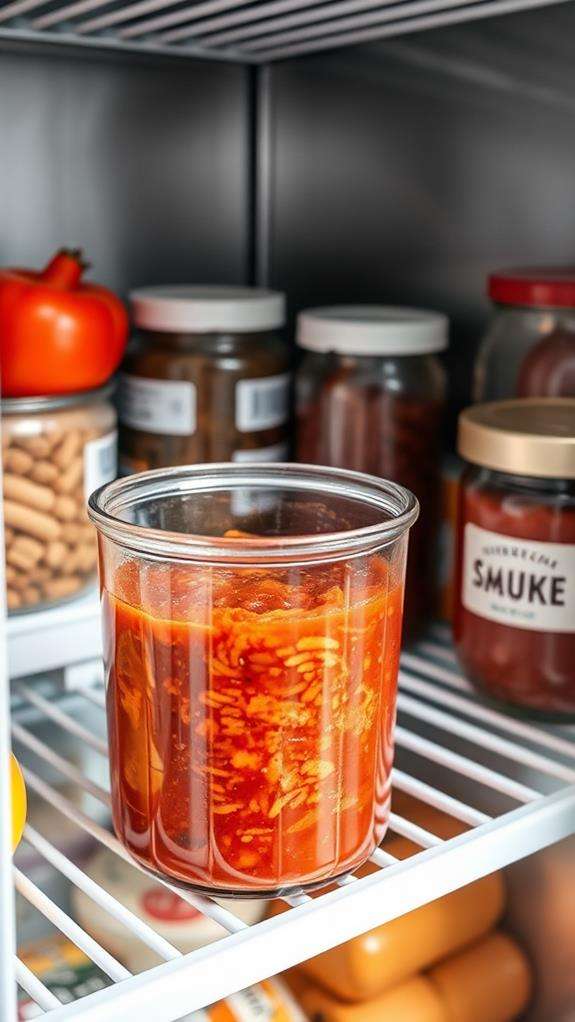
In the refrigerator, homemade spaghetti sauce stays fresh for 3-4 days when stored properly in an airtight container. You'll want to let your sauce cool completely before transferring it to storage, which typically takes about 2 hours at room temperature. For ideal food safety, don't leave your sauce at room temperature for longer than this cooling period.
If you've made a large batch, you can extend your sauce's shelf life by freezing portions in freezer-safe containers or heavy-duty freezer bags. In the freezer, your homemade sauce will maintain its best quality for up to 4-6 months, though it'll remain safe indefinitely at 0°F or below. You'll notice the timeline differs between meat-based and meatless sauces, with meat sauces requiring more careful handling.
For maximum freshness, you should date-label your containers and place them in the back of your refrigerator where temperatures remain most consistent. If you're storing the sauce in multiple containers, remember to rotate them using the "first in, first out" method, ensuring you use the oldest sauce first to prevent waste.
Proper Refrigeration Methods
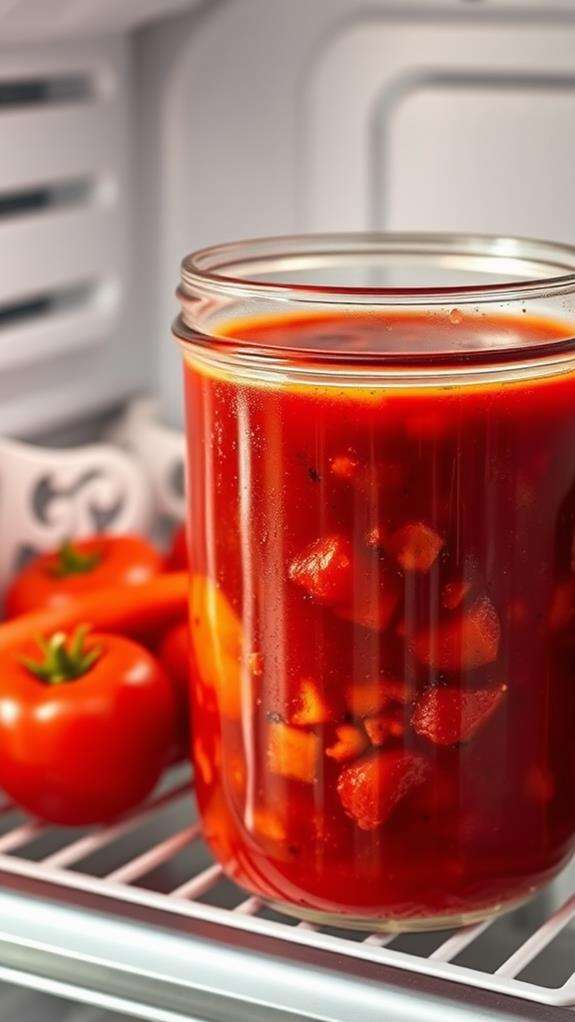
Proper refrigeration starts with selecting the right storage container for your homemade spaghetti sauce. You'll want to use airtight containers made of glass or BPA-free plastic that won't react with the acidic tomatoes in your sauce. Make sure you're choosing containers that allow about half an inch of headspace to prevent pressure buildup as the sauce cools.
Before refrigerating, you'll need to let your sauce cool to room temperature, but don't leave it out for more than two hours. Place the containers in the back of your refrigerator where the temperature remains most consistent, typically between 36-40°F (2-4°C). Don't stack hot containers on top of each other, as this can create warm spots and promote bacterial growth.
If you've made a large batch, consider dividing it into smaller portions. This practice helps the sauce cool more quickly and allows you to thaw only what you need later. You should also label each container with the date you made the sauce and avoid storing it in the refrigerator door, where temperature fluctuations occur frequently due to opening and closing.
Signs of Spoilage
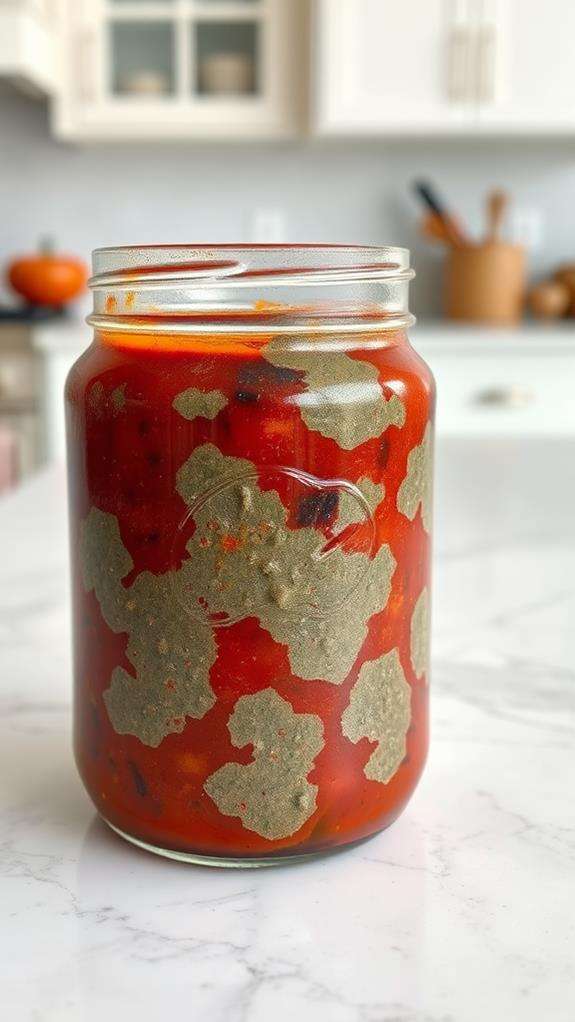
When checking your homemade spaghetti sauce for spoilage, you'll want to look for any discoloration, fuzzy patches, or unusual spots that indicate mold growth on the surface. Your nose is another reliable tool, as spoiled sauce will often give off sour, fermented, or otherwise unpleasant odors that differ from its fresh tomato-based aroma. If the sauce's consistency has changed dramatically, becoming unusually watery, separated, or thick with a slimy texture, it's time to discard it rather than risk foodborne illness.
Off-Color or Mold
Spotting discoloration or mold growth provides clear signs that your homemade spaghetti sauce has spoiled. When examining your sauce, you'll want to look carefully at both the surface and sides of the container, as mold can appear in various places. The natural red color of tomato-based sauce should remain vibrant and consistent throughout.
- Dark spots or patches that differ from the sauce's original color indicate bacterial growth, which means you'll need to discard the sauce immediately
- Green, white, or blue fuzzy patches on the surface are definitive signs of mold contamination
- Brown or black discoloration around the container's edges suggests oxidation and potential spoilage
- A grayish film on top of the sauce indicates the presence of harmful microorganisms
If you notice any color variations that weren't present when you first made the sauce, it's best to err on the side of caution. Don't try to salvage partially spoiled sauce by removing the affected areas, as harmful bacteria and mold spores can spread throughout the entire batch even if they're not visible to the naked eye.
Strange Smell Test
Your nose serves as a reliable tool for detecting spoiled spaghetti sauce, working alongside visual inspection to confirm food safety. When you open your container of homemade sauce, take a moment to perform a careful sniff test. Fresh spaghetti sauce should have a pleasant, slightly sweet tomato aroma with notes of herbs and garlic.
If you detect any sour, fermented, or unusually sharp odors, your sauce has likely begun to spoil. Pay particular attention to acidic or vinegar-like smells, which often indicate bacterial growth. You'll want to notice if there's an ammonia-like scent or any musty undertones, as these are clear warning signs of decomposition. When meat is present in the sauce, be especially vigilant for rancid or putrid aromas, which signal protein breakdown. Don't ignore subtle changes in smell – even slight variations from the sauce's original aroma can indicate early stages of spoilage. If you're unsure about the smell, it's better to err on the side of caution and discard the sauce rather than risk foodborne illness.
Texture Changes Significantly
Any noticeable changes in your spaghetti sauce's texture can signal spoilage. When examining your homemade sauce, you'll want to look for specific textural indicators that suggest it's no longer safe to consume. The consistency of your sauce should remain relatively stable when properly stored in the refrigerator.
- If you notice your sauce has become unusually watery with liquid pooling on top, while the solids have separated and sunk to the bottom, it's likely breaking down due to bacterial growth
- When your sauce develops a slimy or gelatinous film on its surface, this indicates the presence of harmful bacteria that have begun decomposing the ingredients
- If the texture has become grainy or gritty, especially in areas where it was previously smooth, you're likely seeing the effects of temperature fluctuations and spoilage
- When chunks of vegetables or meat in your sauce appear mushy or have developed a mealy consistency, despite being properly cooked initially, bacterial activity has likely compromised the food's structural integrity
Don't attempt to salvage sauce showing these textural changes by reheating or removing affected portions, as bacteria may have spread throughout the entire batch.
Extending Shelf Life
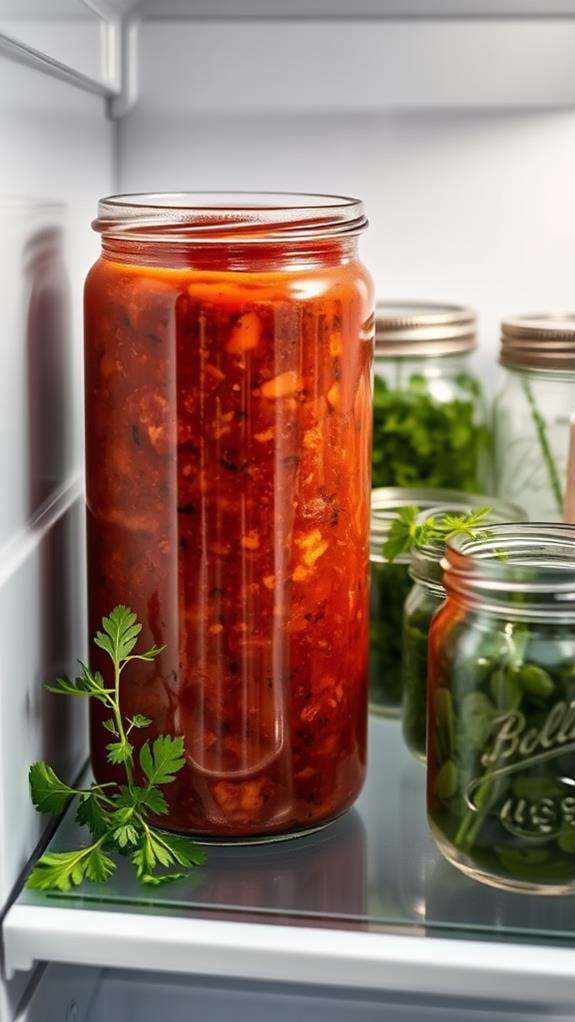
Several proven methods can extend your homemade spaghetti sauce's shelf life considerably. You'll want to start by cooling your sauce quickly after cooking, using an ice bath or shallow containers to speed up the process. Once it's at room temperature, transfer the sauce to airtight containers, leaving minimal headspace to reduce oxidation. For added convenience in food prep, think about using a food processor to finely chop your ingredients before cooking, which can enhance flavor integration and texture.
To maximize storage time, you can employ proper acidification techniques by adding the right amount of lemon juice or citric acid, which will help maintain a pH level below 4.6. If you're planning to keep the sauce longer than 3-4 days, contemplate portioning it into smaller containers before freezing. You'll find that vacuum-sealed bags work exceptionally well, as they prevent freezer burn and maintain flavor integrity for up to six months.
For refrigerated storage, verify your fridge maintains a consistent temperature below 40°F (4°C). Using sterilized glass containers can also help prevent bacterial growth. If you're interested in long-term preservation, you might want to think about pressure canning, which can extend shelf life to up to one year when stored in a cool, dark place.
Container Selection and Storage
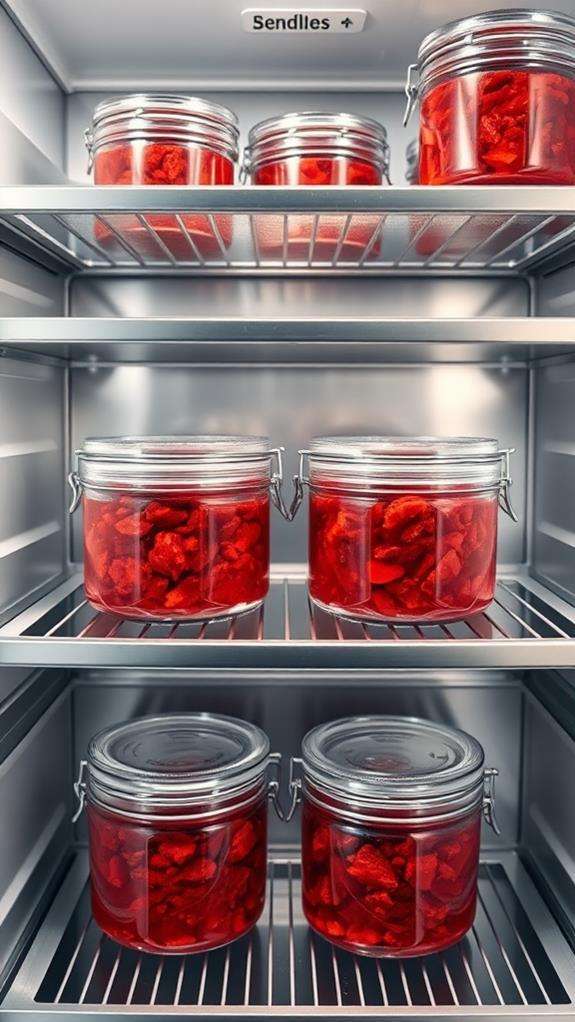
When storing your homemade spaghetti sauce, you'll need to select between glass containers, which offer better temperature stability and won't absorb stains or odors, and plastic containers, which are lighter but may discolor over time. You'll want to verify your chosen container has an airtight seal that prevents both oxidation and potential contamination from outside elements, while also allowing enough headspace for the sauce to expand slightly if frozen. For prime storage conditions, keep your refrigerated sauce at or below 40°F (4°C), and if you're using the freezer, maintain a consistent temperature of 0°F (-18°C) or lower.
Airtight Container Best Practices
Proper storage containers make a significant difference in keeping your homemade spaghetti sauce fresh. When you're selecting an airtight container, you'll want to guarantee it's made from food-grade materials that won't react with acidic tomatoes or absorb flavors. Glass containers with secure, well-fitting lids are often your best choice for maintaining sauce quality and preventing leaks.
- Check the lid's seal by running your finger around the rim, assuring there aren't any cracks, warping, or debris that could compromise the airtight barrier
- Fill your container leaving about 1/2 inch of headspace at the top to allow for slight expansion when the sauce cools
- Wipe the rim clean before securing the lid to prevent any sauce residue from breaking the seal
- Test the container's seal by turning it upside down (over the sink) before refrigerating
You'll want to label your container with the date you made the sauce, using either a permanent marker on masking tape or a dedicated food storage label. If you're using plastic containers, choose BPA-free options that are specifically designed for hot foods and won't stain from tomato-based sauces.
Proper Temperature Settings
Maintaining ideal temperature settings makes all the difference in preserving your homemade spaghetti sauce. You'll want to keep your refrigerator temperature at or below 40°F (4°C), which is the best range for preventing bacterial growth in your sauce. This temperature zone, known as the "food safety zone," helps maintain your sauce's quality and extends its shelf life.
When you're first storing your sauce, don't place it in the refrigerator while it's still hot. Instead, let it cool at room temperature for no more than two hours before refrigerating. Once you're ready to store it, place the container in the back of your refrigerator, where temperatures remain most consistent. Avoid storing it in the door, as frequent opening and closing can cause temperature fluctuations.
For longer-term storage, your freezer should be set at 0°F (-18°C) or below. At this temperature, you'll effectively halt bacterial growth and preserve your sauce's flavor profile. Remember to check your appliance's temperature settings regularly using a reliable thermometer, as built-in gauges aren't always accurate. These precise temperature controls will help maintain your sauce's safety and taste.
Glass Vs Plastic Storage
The choice between glass and plastic containers can greatly impact your homemade spaghetti sauce's longevity and quality. When storing your sauce, you'll need to take into account several factors that affect both preservation and food safety. Glass containers typically offer superior protection and durability, while plastic options provide convenience and portability.
- Glass containers won't absorb flavors or stains, making them ideal for acidic tomato-based sauces that can discolor plastic
- High-quality plastic containers are more lightweight and less prone to breakage, but they may develop surface scratches that harbor bacteria
- Glass vessels maintain temperature consistency better and won't leach chemicals when reheating, unlike some plastic varieties
- BPA-free plastic containers are safe for refrigeration but shouldn't be used for hot sauce storage, as heat can compromise their structural integrity
If you're planning to store your sauce for more than a few days, opt for glass containers with airtight lids. They're easier to clean thoroughly, resist odors, and won't warp or deteriorate over time. When using plastic containers, make sure they're specifically designed for food storage and always cool your sauce completely before transferring it.
Freezing Your Meat Sauce

Successfully freezing your homemade meat sauce extends its shelf life up to 4-6 months. To properly freeze your sauce, you'll need to let it cool completely to room temperature first, which typically takes about 2 hours. Don't rush this step, as putting hot sauce directly in the freezer can affect both food safety and texture quality.
When you're ready to freeze, portion your sauce into freezer-safe containers or heavy-duty freezer bags, leaving about an inch of headspace to allow for expansion. You can measure out meal-sized portions, such as 2-cup or 4-cup servings, making it easier to thaw only what you need. If you're using freezer bags, remove as much air as possible before sealing to prevent freezer burn. Label each container with the date and contents, then place them in the coldest part of your freezer, typically toward the back. For best texture, store your sauce at 0°F (-18°C) or below. When you're ready to use your frozen sauce, transfer it to the refrigerator and let it thaw overnight. Once thawed, use the sauce within 3-4 days for best results.
Reheating Guidelines and Safety
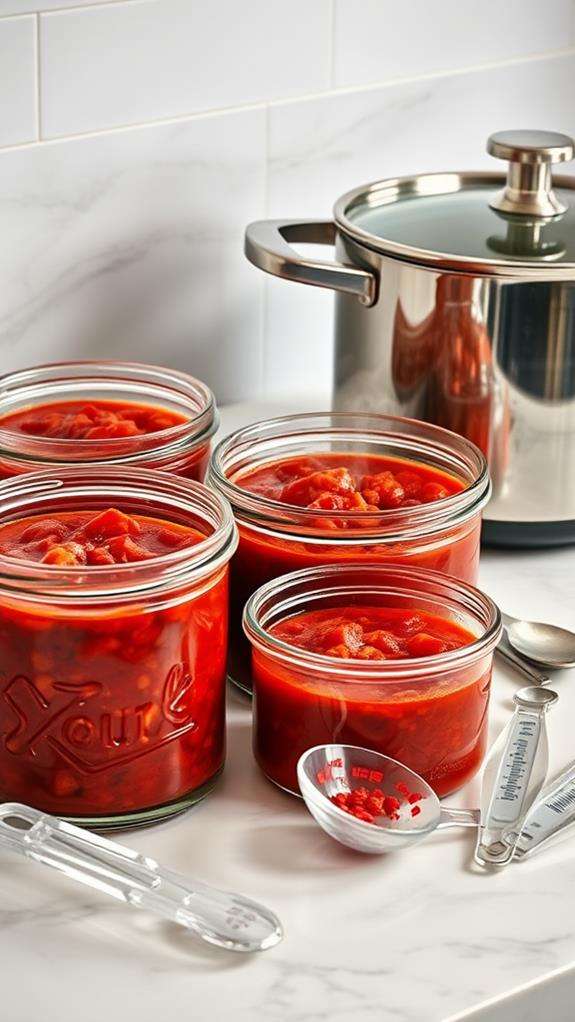
After thawing your frozen sauce or storing fresh sauce in the refrigerator, proper reheating techniques guarantee both safety and flavor preservation. You'll need to verify your sauce reaches a safe internal temperature of 165°F (74°C) to eliminate any potential bacterial growth that may have occurred during storage.
- Heat your sauce in a saucepan over medium heat, stirring frequently to prevent sticking and verify even temperature distribution.
- If you're using a microwave, place the sauce in a microwave-safe container and heat in 30-second intervals, stirring between each interval to eliminate cold spots.
- When reheating meat sauce, use a food thermometer to verify the temperature has reached 165°F throughout.
- Don't reheat your sauce more than once, as multiple reheating cycles can compromise both safety and quality.
You'll know your sauce is properly reheated when it's steaming and bubbling consistently throughout. If you notice any odd odors or see signs of separation that won't recombine with stirring, it's best to discard the sauce. Remember to transfer any leftover reheated sauce back to the refrigerator within two hours to maintain food safety standards.
Frequently Asked Questions
Can I Add Fresh Herbs to Leftover Meat Sauce Before Storing?
You can add fresh herbs to leftover meat sauce before storing, but it's best to wait until you're ready to reheat and serve. Fresh herbs tend to lose their vibrant flavor and can become wilted or discolored when stored in liquid. If you'd like to enhance your sauce's flavor during storage, stick to dried herbs instead. They'll maintain their taste better and won't affect the sauce's storage life or quality.
Does Adding Wine to the Sauce Affect Its Refrigerator Shelf Life?
Did you know that alcohol content in wine reduces by 85% after cooking for 15 minutes? When you add wine to your sauce, it won't greatly impact its refrigerator shelf life. The alcohol evaporates during cooking, and the remaining compounds actually help preserve your sauce slightly due to wine's natural antimicrobial properties. You'll still want to follow the standard 3-4 day storage guideline, though, since the meat remains the primary factor in determining spoilage.
Should I Let Meat Sauce Cool Completely Before Mixing With Cooked Pasta?
Yes, you should let your meat sauce cool down before combining it with pasta. Hot sauce can continue cooking your pasta, making it mushy, and the excess heat creates unwanted condensation when stored. You'll get the best texture and flavor if you wait about 15-20 minutes until your sauce reaches room temperature. If you're planning to store leftovers, cooling the sauce first also prevents bacterial growth.
Can I Store Meat Sauce and Meatballs Together in the Same Container?
You can absolutely store your meat sauce and meatballs together! They're actually perfect storage companions since they share similar flavors and ingredients. You'll want to place them in an airtight container, making sure there's enough sauce to keep the meatballs moist. This storage method not only saves space but also allows the flavors to continue melding together. Just remember, they'll follow the same storage guidelines as your regular meat sauce.
Will Storing Sauce in Metallic Containers Affect the Taste Over Time?
Yes, storing tomato-based sauces in metallic containers can affect the taste due to a chemical reaction between the acid in tomatoes and the metal. You'll want to avoid aluminum and unlined metal containers, as they can create a metallic taste and potentially cause the sauce to discolor. Instead, you should use glass, plastic, or stainless steel containers to store your sauce. These materials won't react with the acidic ingredients.





